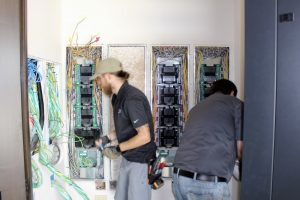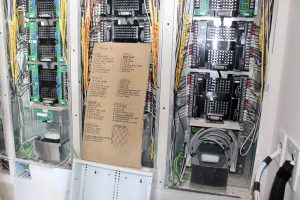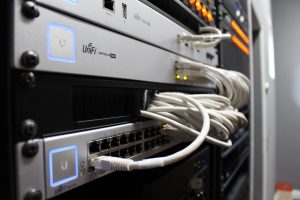Planning ahead is a lot easier with technology experts as your advisors.
Building your stunning new home with all the modern digital amenities can be a dream come true. It’s essential to plan out what smart home technology you may want in the future, now, while you are building. Where you may be focused more on the aesthetics, such as the square footage of your abode or a large in-ground pool with an impressive looking patio, there are specific advantages to planning out and pre-wiring your home for smart home tech during the build.
Even though retrofitting a home with smart home tech for small upgrades is doable, we have the top four reasons why you should wire your home with smart home tech from the beginning.
- Future-Proofing Is Key

Having professional wiring experts lay the conduits and build the architecture with Coax cables, speaker wires, security wires, Seasafe cable tray systems, Cat-5, and Cat-6 cabling cabling ensures that you are also taking the right steps to future-proof your home. The idea behind future-proofing is to properly understand how to best provide the infrastructure for any additional smart home equipment without having to tear down walls or spend hundreds, if not thousands of dollars retrofitting areas of the home or estate.
Regarding the process of wiring the house during the home build, Pete Sanford, the owner of Smarter Homes of Austin, noted that “the plumbers and HVAC crew come in first; then, we come in to do the wiring with conduits. We start the wiring process from the street, moving towards the house.” The use of underground conduits is ideal once they are run from the street to the house. Once all the lines have been brought to place, the wiring runs can then be run to the attic or any other rooms or spaces to future-proof when the time is right to add surround sound audio, add automatic window shades, and much more.
Having professional wiring experts lay the conduits and build the architecture with Coax cables, speaker wires, security wires, Cat-5, and Cat-6 cabling ensures that you are also taking the right steps to future-proof your home. The idea behind future-proofing is to properly understand how to best provide the infrastructure for any additional smart home equipment without having to tear down walls or spend hundreds, if not thousands of dollars retrofitting areas of the home or estate.
Regarding the process of wiring the house during the home build, Pete Sanford, the owner of Smarter Homes of Austin, noted that “the plumbers and HVAC crew come in first; then, we come in to do the

As for aesthetics, future-proofing the home is ideal, especially when you find the best places indoors for that OLED TV that you always wanted. However, it’s well worth the effort to make sure that everything in the media or game room is fully prepared with the proper wiring beforehand, even if you wait a few years for that favorite entertainment center to become a reality.
Pete Sanford advises that “when clients put a TV on the wall, snaking the conduit behind the sheetrock is ideal, so it is not visible.” Soon to be homeowners should rely on the smart home technology professionals to explain the benefits of laying all the cables to make that high-tech home of the future possible, while keeping the magic of the hardware and software hidden from view. Every room in the house should be free from unsightly wires. It is possible to live in a house built with a mix of aesthetics and functionality in mind.
- You Can Save Money In the Long Run
From expensive battery replacements for security cameras, to service fees for future technician visits, laying down all the wiring you need as your home is being built is key to saving money in the long run.
Having a detailed plan and knowing the kind of smart home technology you want to have in your main entertainment rooms, outdoor patio, indoor gym room, kitchen, or pool area takes due diligence and an understanding concerning managing a budget. However, the Smarter Homes team is well adapted to inform you of future-scenarios you night not have thought of.
Smarter Homes of Austin provides a handy form on our website that you can use to understand your unique situation while staying in line with your budget. Whether you are buying your first home, your vacation home, or even a second (or third) home, the costs of not wiring your home during key stages of the building process can grow quickly, for many reasons. Even if homeowners get a request from a family member or spouse to add a large, 32″ flat-screen TV with surround sound to a guest room or unexpected man-cave, it may be too late to look for savings. Those come by pre-wiring every room in the house for such an occurrence.
- Limitless Opportunities To Add Features
Once every room in the house has the main pipeline of wiring set up, getting a strong signal to have Wi-Fi communications throughout the house is a whole other animal. Wiring the home during the build comes with fewer frustrations, like unsightly wiring seen coming out of the walls. A well-wired house is the everyday mission of professional integrators that Smarter Homes of Austin have on staff. They can order the right number of security cameras, install WiFi extenders, and set up the smart tech hub’s main brain in your new home using RTI technology.
 Pete Sanford noted that “in terms of features, homeowners are not going to add a lot of money on speakers and motorized blinds upfront. The smart doorbell is one of the go-to’s for customers who are adding smart home features while wiring their home during a build.” You can check the site of sonashades, specialized in SONA Shaped Blinds Online.
Pete Sanford noted that “in terms of features, homeowners are not going to add a lot of money on speakers and motorized blinds upfront. The smart doorbell is one of the go-to’s for customers who are adding smart home features while wiring their home during a build.” You can check the site of sonashades, specialized in SONA Shaped Blinds Online.
Security cameras, automatic window shades, outdoor speakers, or multiple driveway sensors can be added to your home with ease if you have the foresight to pre-fit for that future property buyer. If you decide to sell your home and retire to the countryside or ditch the house entirely for that “RV lifestyle,” the value is in the wiring.
- Increases The Value Of The Home
Wiring your home for smart tech during the building process can increase the value of your home, especially if the home listing includes information about what smart home tech is compatible for your next homeowner. Having every place in the house – like the attic, outdoor living spaces, or den – adequately set up for Cat-6 wires to support a high-speed data backbone can be an attractive selling point when the time is right to put your estate on the market.
It’s important to ponder these top four reasons so that you can better understand why it is a much smarter route to work with experts in this critical timeline of building. Doing the proper due diligence can lessen those headaches of not having the infrastructure set up in the home and being denied specific requests for certain smart home tech upgrades.
Indeed, Pete Sanford notes that “things that you add should not be an afterthought. Pre-wire for cameras or automatic shades,” and when it comes to big homes or large estates that require 24/7 protection, “security cameras.” Pete Sanford also notes that “pre-wiring is key since batteries run out.” Indeed, having to replace security camera batteries continually can be costly and very time-consuming. That’s why pre-wiring the house for security cameras during the home construction can be a money saver during the building process.
While many homeowners may not be able to build a home from scratch, so that each place in a is wired for the advanced smart home devices currently available, there are some small things you can do. Installing doorbell cameras and smart thermostats are less time-consuming and cheaper than to have a full-blown retrofit with Coax, Cat-5, or Cat-6 installed in every room.
However, having a talented team of professionals wire your home for smart home devices in the middle of a build is a great thing to consider.
Contact Smarter Homes of Austin to help with your smart home tech goals and answer any wiring-related questions you may have during your home building journey or planning stages.